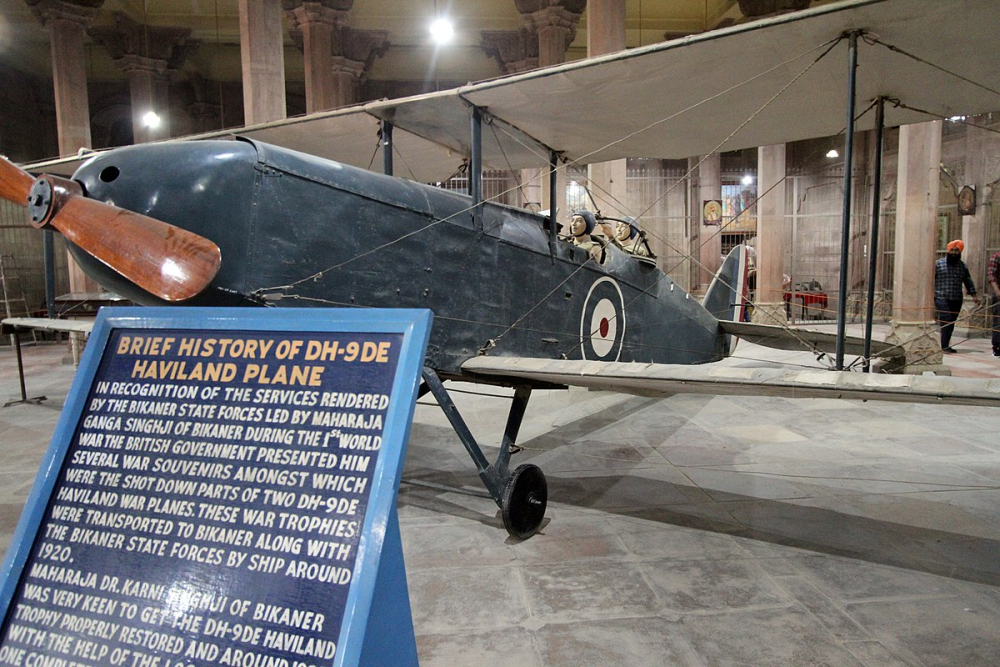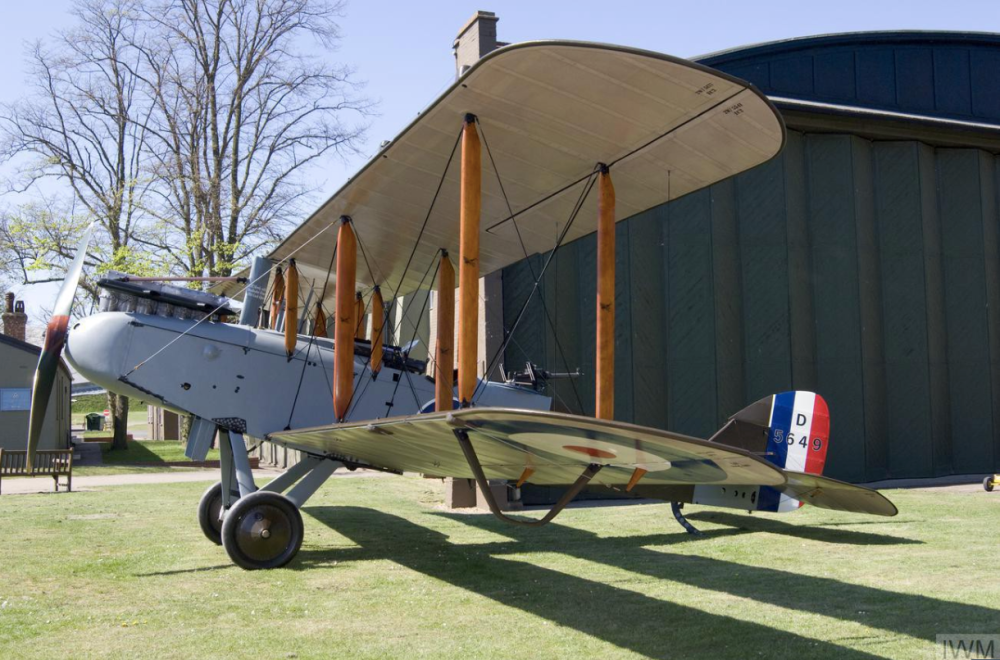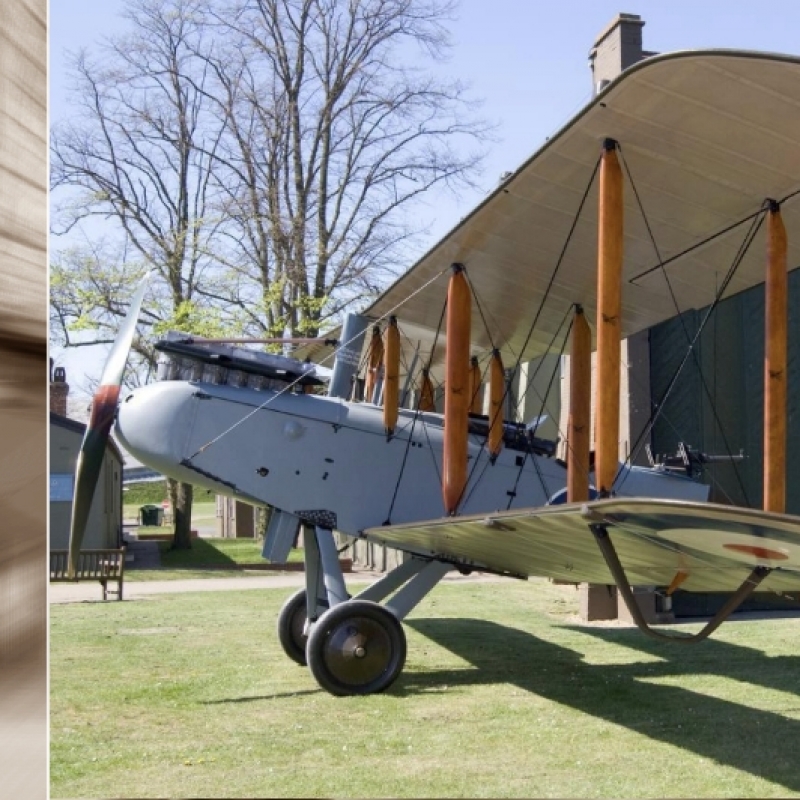Seemingly out of place in the durbar hall of the Junagarh Fort Museum in Bikaner, the DH.9 (de Havilland) bomber from World War I takes pride of place. Tracing the journey of how this war relic made its way to India, we take a ride with the camel cavalry of Maharaja Ganga Singh, a deep dive into the elephant stables of the fort and find out about an Air Force that never came into being. (Photo courtesy: Imperial War Museum)
Walking into the Vikram Vilas Durbar Hall, a 1935 addition to the sixteenth-century Junagarh Fort and Museum in Bikaner, you encounter an unexpected sight: a DH.9 (de Havilland) DE World War One (WWI) bomber plane. Compared to the rest of the fort museum—with its seven palaces, courtyards, pavilions and balconies featuring traditional Rajput architecture and artwork—this space is distinct.
Junagarh Fort (‘juna’, meaning ‘old’) was built between 1589 and 1593 by Raja Rai Singh, Bikaner’s then ruler. Since then, each successive maharaja has made additions during their respective reigns.[1] In 1902, the royal family moved to Lalgarh Palace, and Junagarh became a heritage site. In 2000, a section was converted into the Prachina Museum, which showcases objects and furniture that reflect the family’s everyday life.[2] In comparison, the exhibits in the Vikram Vilas Durbar Hall, therefore, refer to a lesser-known part of Rajput history—one of fighting on behalf of the British, and the role of the camel cavalry in the world wars.
Also read | The Oft-forgotten Rajasthan’s Maharaniyon ki Chhatriyan
While one would imagine the impressive bomber to represent mechanised warfare, it is, in fact, intimately connected to a more unique, regional and traditional Rajput military culture of many centuries. Known as the Ganga Risala (cavalry), the camel regiment in connection was founded by Maharaja Ganga Singh in the late nineteenth century, and has many international battles to its name. For instance, the Boxer Rebellion in China in 1900, and then in Somalia in 1902–4. [3]

Camel Cavalry in the World Wars
So, how is this camel regiment connected to the bomber in the durbar? In 1914, Maharaja Ganga Singh offered the British a 500-strong camel corps. According to historian Vinay Nalwa, the maharaja ‘was the first among the Indian kings to be conferred the rank of “General” by British Emperor’, and was also the only non-white participant in the Imperial War Cabinet.[4] The camel regiment was deployed in Egypt in 1919, defending the Suez Canal from Turkish advances so successfully that further camel-mounted regiments were formed from Commonwealth troops for guerrilla campaigns in arid places such as the Palestine and Sinai.[5] The Ganga Risala was deployed again in World War II in the Middle East.[6]

A Flighty Present
According to the museum signage, ‘in recognition of the services rendered by Bikaner state forces…the British government presented…several souvenirs amongst which were the shot down parts of two DH-9 de Havilland war planes.’ Transported by ship with surviving troops and their camels, the pieces of these planes—the de Havilland (DH) single-engine biplane, built in Hertfordshire, England, and deployed for strategic day bombing of German cities in 1918—found their way to Junagarh Fort in 1920. It’s said that Maharaja Dr Karni Singh, Ganga Singh’s son, and local craftspeople pieced one of the planes together and it was put on display in the Vikram Vilas Durbar Hall.
Also see | African Cavalry Guards: Hyderabadis of Afro-Arab Descent
Incidentally, there was a broom handle for the engine, a carved plank made into a propeller, and some wheelbarrow wheels in place of proper landing gear—using jugaad to good effect where they did not have original pieces.[7] The extremely rare Siddeley Puma 240 engine had been repurposed to power water pumps for a canal project in 1920, part of Maharaja Ganga Singh’s efforts to irrigate Bikaner’s dry lands.[8]
In 1920, 60 DH.9 planes were given to India by Britain under the ‘Imperial Gift Scheme’—post-war surplus given to colonies and commonwealth countries to create their own air forces, also partly to pay back wartime contributions.[9] Due to a lack of pilots, guns and training manuals, the planes were never used for an Indian Air Force but distributed amongst various states, firms and private individuals. It is unclear how many DH.9s came to Bikaner, and if the plane on display was actually part of this larger scheme, nevertheless, in 1999, a British backpacker circulated a photo of their crumbling remains hidden behind the Junagarh Fort, which reached Guy Black, who runs Aero Vintage, a specialist aeroplane restoration company in Sussex. Three years later, Black visited and discovered, ‘among piles of elephant saddles, the airframe of the DH.9, engineless, its timbers partly eaten by termites and much of its fabric covering missing’.[10]

From Elephant Stables to the Imperial War Museum
The DH.9, while popular during WWI, had become increasingly rare and was entirely absent from the UK.
After negotiations with the royal family, Black bought and transported parts of two planes to the UK. He restored both, selling one to the Imperial War Museum for nearly 1 million pounds, now hanging in Duxford Aircraft Hangar in Cambridge, England.[11] The other is owned by Historic Aircraft Collection Limited and was flown at Duxford in 2019, a century after taking flight from the same airfield for WWI bombing raids. This plane is currently the only WWI plane and specifically DH.9 flying today. Perhaps ironically, a plane given away as surplus is now treasured by museums across the world.[12]
The cross-continental journeys of these de Havilland bombers in the aftermath of WWI highlights the value of the oft-forgotten Indian wartime contribution. At the Junagarh Fort Museum, the plane represents the success of the camel regiment, designed for desert conditions for which British forces were unprepared. Such stories and geographies have been rarely covered in war films that focus on mechanical weaponry. As for the camel regiment, although dismounted in 1974, it continues to patrol the harsh Thar Desert as part of India’s Border Security Force, a traditional form of transport and cavalry still useful into the modern age.[13]
This content has been created as part of a project partnered with Royal Rajasthan Foundation, the social impact arm of Rajasthan Royals, to document the cultural heritage of the state of Rajasthan.
This article was also published on Scroll.
Notes
[1] Lonely Planet, ‘Junagarh Palace, Bikaner’, accessed November 19, 2020, https://www.lonelyplanet.com/india/rajasthan/bikaner/attractions/junagarh/a/poi-sig/1148973/356464.
[2] Prachina Museum, About Us, accessed November 12, 2020, https://www.prachinamuseum.org/about-us.html.
[3] Mandeep Singh Rajwa, Vignette 6: The Indian Army’s Camel Troops, 1948-75, Indian Military History, accessed November 12, 2020, https://www.indianmilitaryhistory.org/india/camel_1948-75.html.
[4] Newsroom Post, The Saga of Ganga Risala, accessed November 11, 2020, https://newsroompost.com/news-of-the-day/the-saga-of-ganga-risala/425210.html.
[5] Imperial War Museum, 10 Incredible Photos of the Imperial Camel Corps, accessed November 19, 2020, https://www.iwm.org.uk/history/10-incredible-photos-of-the-imperial-camel-corps; S.C. Mehta, B.P Mishra, and M.S. Sahani, Genetic differentiation of Indian camel (Camelus dromedarius) breeds using random oligonucleotide primers, National Research Centre on Camels, Bikaner, accessed December 15, 2020, http://www.fao.org/tempref/docrep/fao/010/a0806t/a0806t07.pdf.
[6] Morrison, Alexander, “Camels and Colonial Armies: The Logistics of Warfare in Central Asia in the Early 19th Century”, Journal of the Economic and Social History of the Orient, vol. 57, no. 4, 2014, pp. 443–485, accessed December 15, 2020, www.jstor.org/stable/43303600.
[7] Guy Black, DH9: From Ruin to Restoration: The Extraordinary Story of the Discovery in India and Return to Flight of a Rare WWI Bomber (Flight Craft) (Grub Street Publishing, 2019), 22.
[8] Ibid., 21.
[9] A breakdown of the sixty planes, and where they ended up. Air History, The Imperial Gift Scheme, accessed October 30, 2020, http://www.airhistory.org.uk/gy/ImperialGift-India.html.
[10] Nigel Reynolds and Stephanie Condron, Maharajah’s bomber spreads its wings again, Telegraph Newspaper, 20 April 2007, accessed November 19, 2020,
http://webcache.googleusercontent.com/search?q=cache:pk4wtxkoOaAJ:https://www.telegraph.co.uk/news/uknews/1549157/Maharajahs-bomber-spreads-its-wings-again.html&hl=en&gl=uk&strip=1&vwsrc=0; AeroNews, Rare de Havilland planes restored: Found rotting in palace elephant stables, accessed November 19, 2020,http://www.aero-news.net/index.cfm?do=main.textpost&id=b55f8cab-f9d1-4f81-b60d-b4a52a3004b1.
[11] Nigel Reynolds and Stephanie Condron, 'Maharajah's bomber spreads its wings again', Telegraph newspaper, 20 April 2007, accessed November 12, 2020,
[12] Imperial War Museum, De Havilland DH.9 - First Public Display - Duxford Flying Legends Airshow 2019, YouTube, accessed November 19, 2020,
[13] Aparna Menon, 'Did you know The Border Security Force has a camel band? Here’s all about BSF and Its Camels', The Better India, accessed December 15, 2020,https://www.thebetterindia.com/39521/border-security-force-bsf-camelry-camel-band/.












